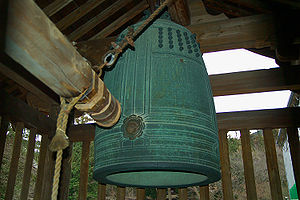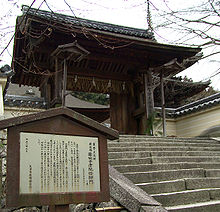- Mii-dera
-
This article is about the temple in Shiga Prefecture. For the temple in Nara Prefecture, see Mii-dera (Nara).
Mii-dera
三井寺
Mii-dera no Bansho (三井寺の晩鐘), the evening bell at Mii-dera. Information Denomination Tendai Jimon Founded 672 Founder(s) Emperor Temmu Address 246 Onjō-ji-chō, Ōtsu, Shiga Country Japan Website www.shiga-miidera.or.jp/ Video
Mii-dera (三井寺,御井寺), formally called Onjō-ji (園城寺), is a Buddhist temple located at the foot of Mount Hiei, in the city of Ōtsu, in Shiga Prefecture.[1] It is only a short distance from both Kyoto, and Lake Biwa, Japan's largest lake. The head temple of the Tendai Jimon sect, it is something of a sister temple to Enryakuji, at the top of the mountain, and is one of the four largest temples in Japan. Altogether, there are 40 named buildings in the Mii-dera temple complex.
Mii-Dera is temple number 14 in the Kansai Kannon Pilgrimage.
Contents
History
Founding, and feuds
Onjō-ji was founded in the early Heian period.[2] The temple was founded in 672 following a dispute over Imperial succession. Emperor Tenji had died, and his son was killed by Tenchi's brother, who was then enthroned as Emperor Temmu. Temmu founded Onjō-ji in honor and memory of his brother.
The name "Mii-dera," literally 'Temple of Three Wells,' came about nearly two centuries later. It was given this name by Enchin, one of the earliest abbots of the Tendai Sect. The name comes from the springs at the temple which were used for the ritual bathing of newborns, and in honor of Emperors Emperor Tenji and Emperor Temmu, and Empress Jitō, who contributed to the founding of the temple. Today, the Kondo, or Main Hall, houses a spring of sacred water. Under Enchin's guidance, from 859 to his death in 891, Mii-dera gained power and importance, eventually becoming (along with Tōdai-ji, Kōfuku-ji, and Enryaku-ji) one of the four chief temples charged with the spiritual guidance and protection of the capital. It was during this time also that Enryaku-ji & Mii-dera split away from one another, developing two branches of the Tendai sect, called Jimon and Sammon. For the most part, this was more a geographic rivalry than an ideological schism, but it was an intense one nonetheless, and only grew more severe after Enchin's death.
The rivalry turned violent in the second half of the 10th century, over a series of official appointments to other temples, and similar slights. The zasu of Enryaku-ji in 970 formed the first permanent standing army to be recruited by a religious body. Mii-dera can be assumed to have established one very soon afterwards. In 989, a former abbot of Mii-dera by the name of Yokei was to become abbot of Enryaku-ji; but none of the monks of Enryaku-ji would perform services under his direction. He soon resigned. But in 993, the monks of Mii-dera took revenge, destroying a temple where Ennin, founder of Enryaku-ji's Sammon sect, had once lived. The monks from Enryaku-ji retaliated, destroying more than 40 places associated with Enchin. In the end, over 1,000 monks of Enchin's Jimon sect fled permanently to Mii-dera, cementing the split between the two Sects. Over the course of the 10th, 11th and 12th centuries, there continued to be similar incidents, over the appointment of abbots (zasu), involving many sōhei, or warrior monks. Mii-dera was burned to the ground by the sōhei of Enryaku-ji four times in the 11th century alone. There were, however, times that the two united against a common enemy, including an attack on the Kōfuku-ji in Nara in 1081 (avenging the burning of the Mii-dera by Kōfuku-ji monks that same year), and a united attack on Nara once more in 1117.
The Genpei Wars
At the end of the 12th century, the attentions of the monks of Mount Hiei were turned towards a greater conflict: the Genpei War. The Taira and Minamoto families supported different claimants to the Chrysanthemum Throne, and in June of 1180, the Minamoto brought their claimant, Prince Mochihito, to the Mii-dera, fleeing from Taira samurai. Mii-dera asked for aid from Enryaku-ji, but was denied. The monks of the Mii-dera joined the Minamoto army, and fled to the Byōdō-in, a Fujiwara clan villa, which had been converted to a monastery by Mii-dera monks. (see Battle of Uji (1180).) Angered at the Mii-dera/Minamoto alliance, Taira no Kiyomori ordered the destruction of Mii-dera, and of many of the temples of Nara. (see Siege of Nara.) The monks of Mii-dera figured once more in the Genpei War, fighting alongside Taira sympathisers against Minamoto no Yoshinaka, who invaded Kyoto in 1184, setting fire to the Hōjūjidono Palace and kidnapping the Emperor Go-Shirakawa.
Following the Genpei War, there was a long period of relative peace, as the temples of Kyoto and Nara, including the Mii-dera, were rebuilt. As the temples regained strength, rivalries reappeared, though little to no violence actually erupted between Mii-dera and Enryaku-ji. In 1367, when a novice from Mii-dera was killed at a toll barrier established by the temple of Nanzenji, warrior monks from Mii-dera set out to attack Nanzen-ji; when the Shogun's forces were sent to quell the rebellion, they discovered Mii-dera's monks to be supported by sōhei from Enryaku-ji and Kōfuku-ji as well. A year later, another battle erupted, over comments made by the abbot of Nanzen-ji; the monks of Mii-dera, along with their allies, defeated the Shogun's forces once again.
Sengoku period and beyond
In the late 16th century, Mii-dera, along with many of the other nearby temples, sought alliances, for military (defensive) strength, as well as military power. The territories of the Asai and Asakura families were closest to Mount Hiei, but these families, as well as others the temples had allied with, were rivals of Oda Nobunaga. These two families suffered heavy defeats at the hands of Nobunaga and his chief general Hideyoshi Toyotomi, so in 1571 they sought a stronger alliance with the temples. That same year, Nobunaga set to destroying everything on Mount Hiei, starting with the town of Sakamoto at the foot of the mountain, and setting his sights on Enryaku-ji at the summit. Much of Mii-dera was destroyed, as the warrior monks failed against Nobunaga's large and highly trained samurai army.
Following these attacks, the monks of Mount Hiei were finally granted a reprieve, and rebuilt their temples once more. Mii-dera has never been attacked or destroyed since then.
Halls & treasures
Within the Kondo and Hondo (the Main Hall and Buddha Hall) of Mii-dera, there are at least six statues of the Buddha, sacred personal possessions of various Emperors, including Emperor Tenji, which are hidden away and shown only on rare, special occasions, as well as one large statue of the Miroku, or Maitreya, Buddha in the center of the Hall. The Kondo was built in 1599, and is a replacement for the original, built in 672 and destroyed by the Taiko Hideyoshi Toyotomi. Mii-dera also has a Kannon-do, built in 1072, a hall dedicated to Kannon, Bodhisattva of Compassion. Mii-dera is the fourteenth temple in a Pilgrimage of 33 Temples devoted to Kannon in the Kansai area.
See also
- List of Buddhist temples
- List of Buddhist temples in Kyoto
- For an explanation of terms concerning Japanese Buddhism, Japanese Buddhist art, and Japanese Buddhist temple architecture, see the Glossary of Japanese Buddhism.
- List of National Treasures of Japan (residences)
- List of National Treasures of Japan (temples)
- List of National Treasures of Japan (ancient documents)
- List of National Treasures of Japan (paintings)
- List of National Treasures of Japan (sculptures)
Notes
- ^ Iwao, Seiichi et al. (2002). Dictionnaire historique du Japon, p. 2134.
- ^ Ponsonby-Fane, Richard Arthur Brabazon. (1956). Kyoto: The Old Capital of Japan, 794-1869, p. 114.
References
- Iwao, Seiichi, Teizō Iyanaga, Susumu Ishii, Shōichirō Yoshida, et al. (2002). Dictionnaire historique du Japon. Paris: Maisonneuve & Larose. 10-ISBN 2-706-81632-5; 13-ISBN 978-2-706-81632-1; OCLC 51096469
- Ponsonby-Fane, Richard Arthur Brabazon. (1956). Kyoto: The Old Capital of Japan, 794-1869. Kyoto: The Ponsonby Memorial Society.
- Sansom, George Bailey. (1958). A History of Japan to 1334. Stanford: Stanford University Press. 10-ISBN 0-804-70523-2; 13-ISBN 978-0-804-70523-3
- Turnbull, Stephen and Wayne Reynolds. (2003). Japanese Warrior Monks AD 949-1603. Oxford: Osprey Publishing. 10-ISBN 1-841-76573-2; 13-ISBN 978-1-841-76573-0
- ____________. (1998). The Samurai Sourcebook. London: Arms & Armour Press. ISBN 1-854-09371-1; 13-ISBN 978-1-854-09371-4; OCLC 60220867 [reprinted by Cassell, London, 2000. 10-ISBN 1-854-09523-4; 13-ISBN 978-1-854-09523-7; OCLC 59400034
External links
- Mii-dera official web site (Japanese)
- York Public Library Digital Gallery, early photograph view of Lake Biwa from Mii-dera
Coordinates: 35°00′48″N 135°51′10″E / 35.01333°N 135.85278°E
Buddhist temples in Japan Japanese Buddhist architecture Architectonic elements Mon (gates) Buildings Chinjusha · chōzuya/temizuya · -dō · main hall (kon-dō, hon-dō, butsuden) · kuri · kyōzō or kyō-dō · shoinTō or Buttō (pagodas) Styles Others A-un · kenSchools and objects of worship Major schools Zen schools Nanto rokushū Objects of worship Amida Nyōrai · Benzaiten · Dainichi Nyorai · Jizō · Kannon · Marishi-ten · Shaka Nyorai · Shitennō (Four Kings) · Twelve Heavenly Generals (Jūni Shinshō) · Yakushi NyoraiOther elements Implements Others bussokuseki · butsudan · Glossary of Japanese Buddhism · Japanese Buddhist pantheon · jingū-ji · miyadera · saisenbakoCategories:- 672 establishments
- Religious organizations established in the 7th century
- Buddhist temples in Shiga Prefecture
- Ōtsu
- National Treasures of Japan
- Important Cultural Properties of Japan
- Asuka period
Wikimedia Foundation. 2010.


